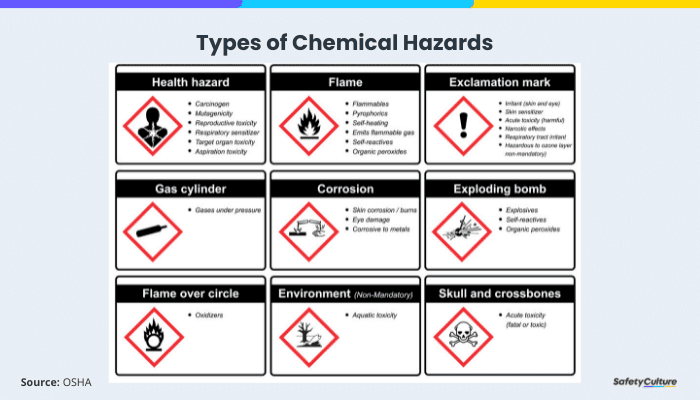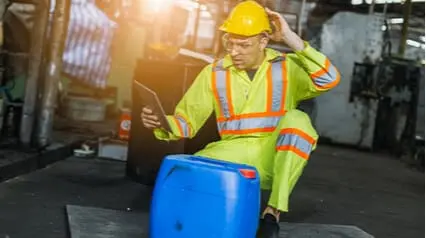What are Chemical Hazards?
Chemical hazards are any substance that can cause adverse physical and health effects to people or result in harm to the environment due to its chemical properties. A chemical hazard can also be defined as the actual risk associated with specific chemicals, such as skin burns, long-term negative impacts on health, lasting environmental damage, fires, or even explosions.
According to Safe Work Australia and the Hazard Communication Standard (HCS) of the Occupational Safety and Health Administration (OSHA), employees must be are aware of the risks and hazards associated with their daily work. Hazard recognition also reduces the chance of exposure to hazardous chemicals and the injuries they can bring.
Types of Chemical Hazards
Although there are several types of chemical hazards that have been generally identified, the following are the chemicals commonly found in the workplace:

- Health hazard – This symbol shows a person with damage and pertains to chemicals that can cause serious and long-term negative impacts on health. Carcinogens are also substances that are known to be cancer-causing chemicals. They are categorized as either natural or manmade, but it is crucial to note that even a small amount of this type of chemical can severely damage human health.
- Flammable – The symbol for this is a flame and it pertains to chemicals or highly flammable gases that may catch fire or ignite once exposed to air or other ignition sources or elements.
- Irritant/hazardous/hazardous to the ozone layer – This is symbolized by a big exclamation point and refers to chemicals that usually cause redness, rashes, or inflammation of the affected area. Although the presence of symptoms is normally short-term, there are still instances where they create long-lasting effects on others. It is also known to either cause harm to individuals or pose a threat to public health by harming the ozone layer.
- Gas under pressure – The symbol for this is a gas cylinder and it pertains to gases that are stored under pressure and may explode if heated or refrigerated gases that may cause burns or injury.
- Corrosion – This pictogram shows corrosion of material and skin. It refers to chemicals that can cause severe skin burns and damage to the tissue once contacted with.
- Explosives – This is symbolized by an exploding bomb and pertains to chemicals that may explode or can cause a mass explosion.
- Oxidizers – This pictogram shows a flame over a circle and symbolizes chemicals or substances that, under certain conditions or exposure to other chemicals or elements, can cause severe physical hazards such as fires or explosions.
- Hazardous to the environment – The symbol for this is a dead tree and fish. It refers to chemicals that can cause lasting damage to the environment.
- Toxic – This pictogram shows a skull and crossbones, and symbolizes chemicals that even at a very low exposure—can cause irreversible changes or mutations to a person’s DNA, damage to health, or even fatality.
Chemical Hazards Examples
Exposure to hazardous chemicals in workplaces can result in adverse health conditions including headaches, difficulty breathing, skin irritation, severe allergic reactions, and other more serious and long-lasting side effects.
Although most hazardous chemicals are easily identifiable, some of them may be used on a daily basis with workers not having prior knowledge of their potential negative effects. Examples of hazardous chemicals in the workplace include:
- Gasoline – Inhalation or skin contact can lead to dizziness, headaches, and in severe cases, respiratory and central nervous system depression.
- Methanol – This is toxic if ingested, inhaled, or absorbed through the skin. Can cause headaches, dizziness, nausea, and, in severe cases, damage to the optic nerve, leading to blindness.
- Disinfectants – Exposure to and skin contact with disinfectants can cause respiratory irritation, skin allergies, and, in some cases, more severe reactions. Some disinfectants may also release harmful fumes.
- Glues – Skin contact may result in irritation or allergic reactions.
- Cleaning materials – Some cleaning agents emit volatile organic compounds (VOCs) that can contribute to indoor air pollution.
- Detergents – Prolonged exposure to detergents may lead to dermatitis while ingestion can cause gastrointestinal irritation.
- Pesticides – Can cause various health risks, including skin and eye irritation, respiratory issues, and sometimes, even neurological damage.
- Paints – Aside from health risks, it can also contribute to air pollution.
- Cosmetics – Certain cosmetics may also contain harmful substances if ingested.
- Welding fumes – Inhaling welding fumes can lead to respiratory irritation, coughing, and in some cases, long-term health effects such as lung damage and cancer.
- Heavy metals including lead, aluminum, and mercury – Accumulation of heavy metals in the body can lead to various health issues, including neurological damage, organ damage, and developmental disorders.
- Metalworking fluids – Some fluids may contain additives that pose additional risks.
Tips to Control Chemical Exposure in the Workplace
Workplaces—especially manufacturing or other related industries—can’t totally eliminate or avoid the use of all hazardous chemicals. What businesses can do to protect their workers, however, is to follow and observe safety measures that aim to control the chemical hazards in workplaces and reduce their potential negative impact on employees.
The following are some preventive measures and other helpful tips on how to proactively maintain a safe working environment for you and your employees:
Identify hazardous chemicals present in your workplace
Primarily, businesses will have to identify hazardous chemicals that are present in the workplace. Some are obvious and easy to recognize, while others are not initially evident. With this process, you’ll have a well-grounded basis on how to best handle each chemical while also allowing your workers to practice safety measures on their own.
Create your own Chemical Safety Audit Checklist
Build from scratch or choose from our collection of free, ready-to-download, and customizable templates.
Browse Chemical Safety Audit ChecklistsAssess risks associated with identified chemicals
Once the hazards are identified, there should be an evaluation of the risks associated with those chemicals, along with the likelihood of those risks occurring. Through a comprehensive risk assessment, businesses will also be able to identify the severity of the risks’ consequences, should they end up happening. This process can be a great deciding factor on which risks should be prioritized and resolved first.
Control the risks
This is the part where businesses will have to decide on how to manage or control the risks identified. When dealing with chemical hazards in workplaces, you must follow the principle of the hierarchy of controls. This concept gives the order or level of how you can potentially control each specific risk. This is the order of the hierarchy and their definitions:
- Elimination – totally remove and discontinue the use of the hazardous chemicals.
- Substitution – find alternatives or replace with other less hazardous chemicals.
- Engineering controls – implement changes in the process such as minimizing the contact with the chemicals, or physically separating people from them.
- Administrative controls – implement changes in the way people work such as rotating their schedules or rearranging job assignments.
- Personal Protective Equipment (PPE) – if hazardous chemicals can’t be avoided, or businesses can’t reduce the contact employees have with them, ensure the use of PPE to lessen exposure and risk factors.
Implement good control measures
Businesses should also have comprehensive and standard control measures that can be followed by all involved personnel and employees to prevent any hazardous effects of chemicals. These measures also help ensure that all relevant stakeholders are on the same page when it comes to chemical safety. However, these should be maintained and reviewed regularly.
Part of implementing and maintaining the right control measures involves constant training and review. For this, it would be best to utilize digital learning courses that you can easily access anytime. Today, there are many available resources such as lessons on handling toxic chemicals, spills, storage practices, and more.
Utilize safety signs and symbols
According to the OSHA, and in compliance with the Hazard Communication Standard (HCS), it is required by law that all chemicals have a label that not only includes what kind of chemical they are, but also the type of hazard associated with them. This is called GHS Pictograms, a safety symbols labeling system that is specific to chemicals. There is also ISO 7000 to consider as a basis for safety signs and symbols.
Perform regular inspections
For all of these efforts to be effective, businesses must perform regular inspections to ensure that they are being followed and consistently practiced. Safety audits can also be a great determining factor to know which control measures work and which don’t. Examples of helpful inspections related to chemicals include chemical safety audits and hazardous materials inspections.
Improve your EHS Management
Cultivate a safe working environment and streamline compliance with our EHS solutions.
Explore nowProtect Your Workplace with SafetyCulture (formerly iAuditor)
Ensure safe handling and controlling of hazardous chemicals in your workplace with the use of a digital safety platform. SafetyCulture is a powerful inspection and auditing tool that businesses can use to implement safety measures with regard to rules and regulations surrounding chemical hazards. SafetyCulture is best utilized in the various processes involved in managing potential negative impacts of hazardous chemicals and can further help you do the following:
- Conduct unlimited inspections, assessments, and audits using digital chemical hazard checklists. Or create your own and customize them according to your business needs and preferences.
- Perform risk assessments, checks of safety signs and symbols, hazardous materials, and PPE inspections. You can also find other templates which may be relevant to your business in our Public Library.
- Share new templates, schedule automatic inspections, and configure user access effortlessly by integrating seamless workflows into your business processes.
- Create corrective actions, report issues, and immediately assign them to relevant personnel for time-sensitive responses.
- Implement a scoring system in your inspections and monitor employee compliance through the tool’s analytics dashboard to ensure continuous process improvement.
- Attach photo evidence in your inspections for high-level visibility and exact references.
- Access all your documents safely, anytime and anywhere, with cloud-based recordkeeping.
- Train employees on proper safety procedures to follow.
- Manage assets for a safer workplace and more streamlined workflow.
FAQs about Chemical Hazards
Examples of chemical hazards include corrosive substances, toxic chemicals, flammable materials, explosive compounds, and reactive substances that may pose risks in various settings.
Chemical hazards are often classified into three types: physical, health, and environmental. This classification is based on their nature and potential harm.
An SDS is a document that provides information about the properties of a chemical product. It includes details on its composition, potential hazards, safe use, and emergency procedures.




